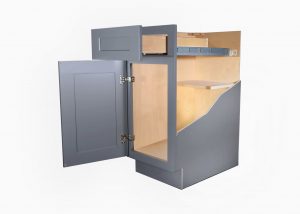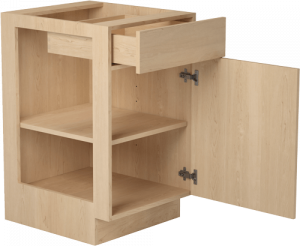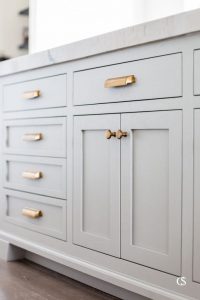Come in and meet with a Carole designer. (Appointments are strongly suggested so we can set aside enough time for a focused, one-on-one meeting.) At your first meeting, your designer will review design possibilities and product options, find out what you like and need, and help prioritize your wish list. Your designer will invite you back for a second meeting to present a preliminary design and estimate at no cost so you feel confident in our skill, expertise, service, and products.
FAQ
It’s common for someone to drop into our showroom or call and tell us the dimensions of their room, and ask, “What is the general cost of new cabinetry?” The answer to this question depends not only on the size of your space, but also whether you plan to change the ‘footprint’ of your kitchen (meaning, will you change walls? impact the electrical and plumbing? etc.), and the quality and features of the products you select (for instance, cherry cabinets typically cost more than maple, and there are many paints, glazes, and cabinet door styles you can choose in addition to the wood you select.). However, a typical 10 foot by 15 foot ‘L-shape’ kitchen ranges anywhere from $3,500 (using our basic, quality stock cabinet line) to over $40,000 (using a full-custom cabinet line, high-end appliances, and special features and accessories—lots of ‘bells and whistles’). What you invest depends on your goals for the room and your home. What’s nice is, because of the product range available, you can get great-looking, quality renovation results for a wide scope of budgets.
As you can probably imagine, every inch matters when putting together the puzzle of cabinets, appliances, etc. You have literally thousands of options for cabinetry styles when you take into consideration paints, glazes, stains, and door style details. There are also many options with countertops, appliances, hardware, etc. Carole kitchen designers are professionally trained in products and layout/design strategy to help you maximize your space in terms of appearance and functionality. Your Carole kitchen designer collaborates with you to provide computer-aided design—a 3-dimensional layout created with software specialized for kitchen and bath design, which allows you to ‘see’ realistic-looking perspectives of your new room. He or she visits your home to do an on-site measure and view your space. Product selection within your budget is another huge piece. Carole designers offer education about the pros and cons of what’s out there and how to help you get the best quality for your investment, and also, suit your personal style. The demo of your original space and installation is handled by your contractor, who is in communication with your designer as needed to ensure accurate installation. If you need a good contractor, we are happy to refer you to one of the many people who we have extensive history working with.
Framed: Framed cabinetry is the more traditional, and perhaps more common cabinet construction type (although many would argue that frameless is actually becoming more popular than framed cabinetry nowadays). A framed cabinet is just like it sounds; a cabinet box with a frame. The door then attaches to the frame.

Frameless: A frameless cabinet is a cabinet where the door attaches directly to the box, and there is no frame (hence, frame-less). Frameless cabinet construction, also known as full access cabinetry, started out in Europe but is becoming more and more popular in the US.

Inset: An inset cabinet is a cabinet where the door is built in to the frame (“inset” into the frame). Inset cabinets give any space a classic look, and can be seen in a lot of craftsman and Victorian era homes. While it can look great, there are a couple of things to be aware of before specifying or purchasing inset cabinets. Inset cabinets are typically more expensive than a standard framed cabinet. It really depends on the cabinet line (and if they even offer an inset option) but many inset styles can run 10-15% more than the framed or frameless options. This upcharge may seem steep but can be worth it if you are going for a specific look. Another thing to consider is that because the door is built in to the frame of the cabinet, you are losing that space that would otherwise be storage. Most cabinet companies make their inset wall cabinets an inch deeper for this very reason, but it will still affect the overall size of your doors and drawers and the way you access your dishes. I have seen people install an inset kitchen, only to realize once their cabinets are installed their plates don’t fit! Oops.
Because all wood expands and contracts, inset cabinets cannot be used in certain climates. The door will expand so much that it will cause damage to the cabinet, or it will contract and leave harsh gaps between the door and frame.

Granite is a naturally occurring stone that is simply cut and polished, while engineered stone, also called quartz (sold under brand names Silestone, Cambria, Zodiaq, Caesarstone) is man-made (using 90-95% quartz, which is one of the hardest minerals on earth). Granite can look more natural and it is recommended that you seal it 1-2 times per year depending on the color. Engineered stone is typically more durable and more uniform in appearance and requires no maintenance. The cost for these products is quite comparable. Carole’s offers both quartz and granite. You can see many, many samples in our showroom.
Yes. Many cabinetry manufacturers are getting on board with the eco-friendly movement in their product design. As you shop, look for these elements in your cabinetry products:
- Urea/Formaldehyde-free plywood or particleboard boxes (as well as particle board made from pre-consumer recycled wood fiber)
- Material that has no VOCs (volatile organic compounds). For example, the manufacturer should use non-toxic water-based glues, adhesives, and finishes.
- Wood that’s responsibly harvested solid wood from Forestry Stewardship Council (FSC) Certified Forests. (Avoid endangered wood species, but if you like the aesthetics of exotic veneer, look for cabinet doors that duplicate that look by using an impregnated veneer or laminate.)
- Made in the USA, or even better, made in the Northeast, for a smaller carbon footprint. (This results in less fuel used for transportation.
White-painted, transitional-style kitchens are still super-popular in Greater-Boston, and in recent years, we have seen an upswing in gray-painted kitchens. We also have had fun designing many unique kitchens, like a recent 2016 kitchen with teal-painted base cabinetry. Yet many clients opt for sleek, contemporary, darker-wood designs. Bottom-line, it’s up to you, and not what’s trending or what your designer may personally like. Someone who plans on renovating now, but selling the house in a few years may make a very different and more strategic real-estate choice than if he or she is planning on being in the house for the next 20 years.
These days, choosing cabinetry is not as simple as choosing the brown or the black version of the shoes or a pump or the flat. But we will guide you through, and narrow the funnel. Just keep in mind that when you look at cabinetry options, you will quickly find that there are many, many versions of one ‘color’ (never mind door styles, which are also incredible in number). For instance, within KraftMaid Cabinetry’s offerings (KraftMaid—known as a ‘semi-custom’ line—is the largest cabinetry manufacturer in the world), ‘white’ appears in many variations, such as; Biscotti, Canvas, Dove White, Vanilla Bean, and Irish Cream.
With full-custom lines/brands, such as Dura Supreme or Elmwood, there are even more options within the ‘white’ category and in some lines, you can even custom-match well-known paint brand colors. Deeper color values such as Peppercorn and Kaffe are prevalent within both modern design and key traditional looks. Finishes such as Praline and Butter Rum Glaze provide a mid-tone value that is growing strong. Honey Spice holds strong as the leading finish for KraftMaid. Glazed finishes continue to be very popular; they provide a furniture appearance to a design and coordinate well when paired with other finishes. It helps to see many displays in person to get a sense of which color appeals to you, and to talk with a designer about how color will impact your particular space, given important factors such as room size and available natural light, etc. So we hope you make a visit to our Showroom and get ideas! Ready to visit for a complimentary consultation? Click here.
It is true. As you know, wood is a product of nature. When you add water to wood, and that certainly includes painted wood, it takes a toll over time. Many of the calls we get about painted cabinets after they have been ‘in-use’ for a while, have to do with the cabinetry around the sink and the trash cabinet.
It’s super-important to be aware of exposure to water and liquids of any type. Be sure to wipe and dry spills and moisture—pronto. Be sure your countertop seal is tight as well. Some people have a pull-out sponge drawer at the front of the sink. Don’t let a soggy sponge sit there or drip down the back of your cabinet panel. No matter how amazing, or high-tech, or careful the finishing process, if you let spills of any kind sit, well…it likely won’t be so good. If you are hard on your kitchen, you should consider this when choosing your style, finish, and color. That’s another way a designer can guide you through the options with a realistic voice of experience.
No matter what finish you have, especially with painted wood, the better you take care of your cabinets, the better they hold up over time.
A wood product is affected by environmental conditions that may alter appearance from what your cabinet looked like when it was new. Keep in mind:
- As wood ages, the appearance of the finish may change or darken over time due to factors such as interior lighting, sunlight, and humidity. Of the most commonly selected wood species, cherry is the one most apt to have noticeable changes within the first year or two.
- Finishes react to prolonged exposure to tobacco smoke, resulting in discoloration, which is especially noticeable on white and lighter finishes.
- Ovens and ranges emit heat and steam during operation. To protect the finish of adjacent cabinets, you may opt to install heat shields. (In fact, on thermofoil cabinetry, heat shields are required by some manufacturers for the warranty.)
- Showroom cabinetry samples, depending on age, room lighting and environmental factors, may look different from the new cabinetry installed in your home.
To ensure satisfaction with a finish color, ask your Carole’s designer to borrow a door sample and take it home to look at in your space. Ask your professional Carole’s designer to describe the intricate differences between their products and how to care for them long-term.
No. We always create a first design based on your rough measurements of your space at no charge. This helps you get a sense of our professional design capability and the potential for your project. It also helps you get comfortable with Carole’s, your designer, and what we offer. If you decide to proceed with us, we charge a retainer fee, which goes toward your cabinetry purchase. We continue refining your design from there. (Your designer has the benefit of our entire team as a sounding board and for critique, with more than 100 years’ worth of kitchen design expertise, as you perfect your customized design together.) Before we finalize a design, we come to your home to do a professional measure.
YES! It’s the largest in the area with more than 50 kitchen displays and a separate In-Stock Vanity Center. We believe that offering you a great showroom helps you determine your likes and dislikes and gets you comfortable with the many, many product options. Come visit us! We are open Monday & Friday from 9-5 p.m., Tuesday, Wednesday, and Thursday from 9-7 p.m., and Saturday from 9-4 p.m. Drop in or request an appointment. (Note: Appointments are always key if you want one-on-one designer time, and a great idea on Saturdays, when the showroom tends to be quite busy).
Already working with a builder or contractor? Great! We will collaborate with them, provide thorough professionally-detailed designs plans, and support your contractor during the entire project. We will work closely with anyone you choose.
Don’t have a builder or contractor yet? No problem! Your Carole’s designer can recommend several options for builders, contractors, and/or cabinet installers. Our referral list is strong and has been cultivated over the years working closely with quality local builders.
